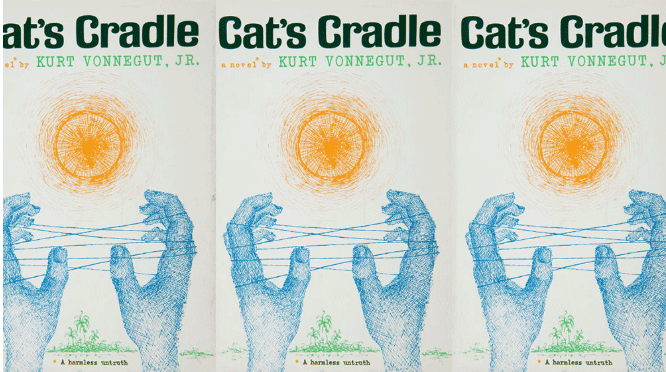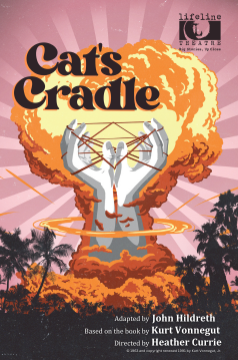by Nina Tavani
The question is not, what is life? But rather, why do we make life what it is?
That’s what I’ve garnered from this book. To a certain extent, it is a commentary on life, and humanity, and so on- but it is also more than that. It asks you, the reader, to look at your life and your habits and observe the why. Why do you say that, even if you know it is a lie? Why do you go there, even if you hate it?
Cat’s Cradle itself is a wonderful and satirical book that has something to say about every aspect of life. It follows the narrator (unnamed) as he attempts to document into a book the day that the atomic bomb went off in Hiroshima. He does so by going to Ilium, New York, the hometown of Frank Hoenikker. Hoenikker, in this novel, is one of the fathers of the bomb. Through various methods, he comes across Honeikker’s children and various other people who would help him on his way. The narrator goes on a journey that brings him all the way to San Lorenzo, an island in the Caribbean. Without giving away too much, it all ends with a prophecy coming true and the world coming to an end.
Part science fiction and part satire, Vonnegut achieved something magical in this novel. While he is by no means a one hit wonder author, this novel still deserves its singular recognition. It may be overshadowed by its successful younger sibling Slaughterhouse 5, it nonetheless has managed to impact many people with its unique structure and style. The novel itself is abnormal: constructed of short snippets of chapters, it reads more like a television script, cutting from each angle to the next. It is not overly complicated, which can make it all the more pleasant to read.
It is a book that gives perspective; it reminds the reader that we are all just part of a bigger web of connected lives, ideas, and beliefs. Vonnegut uses his character’s beliefs and struggles to show the broadness of human emotion and lack thereof. He utilizes these wonderfully crafted beings to show the fickle friend that quick progress can be. The story of the atom bomb runs adjacent to the story of a religion; this brings up the concept of human creativity as pendulum. It can swing to the good, to the bad, or refuse to move at all.
Cat’s Cradle proves that there is both good and evil in each human decision; that there is danger behind every belief system. It is deliciously cynical and inventive. It provides an outlet for emotion; while it gives the reader much to think about, it also snatches many of those thoughts right out of their head.
I recommend this book to anyone who likes to laugh, and who needs a refreshing take on life, science, and humanity. Despite it being an older book, it achieves something many modern novels do not: its message is so broadly applicable and present that it truly deserves the title ‘classic’.

